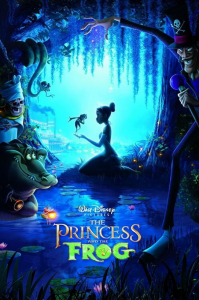35
Friendship Will Prevail Over Differences
By Carrie Cleveland
The Princess and The Frog is a Disney film produced in 2009. The film depicts the adventures of a black waitress, Tiana, after she meets and kisses a frog who claims he is a prince. Throughout the film, Tiana is strong, resilient, and learns that even she can relax sometimes, (she was working two full-time jobs to achieve her dream of owning her own restaurant). In the beginning of the film, Tiana is shown in her childhood, listening to a story with her good friend, Charlotte, who is white and spoiled. Charlotte receives everything she didn’t know she wanted until she got it, while Tiana’s mother is a seamstress and her father is a working man. We don’t see much of Charlotte after the opening scene, but when we do see her, she is severely spoiled. She is so spoiled she can just grab handfuls of money out of her father’s shirt pocket to pay for treats at a masquerade ball being thrown just so she can meet and potentially marry Prince Naveen from Maldonia. Her openhanded generosity is what enables Tiana to afford the downpayment on the abandoned factory she wants to turn into a restaurant. Tiana is shown a few minutes prior saying, “… every little bit counts…” about the few coins she received as tips at her first job.
The prince is important as he is both white and irresponsible with his money, which is why he was cut off from his parents. Charlotte is also white and spends her father’s money without asking him if she can. She thinks that the prince would be the perfect match for her without knowing anything about him or his lifestyle. From what we see in the film, they would feed off of each other and be forever poor. When Tiana meets him as a frog, she does attempt to get to know him. In the end, Tiana helps the prince realize that he doesn’t really want to return to his old ways and he would be much happier wherever she is.
Power can be expressed in that Charlotte is white and living with her rich father who spoils her rotten while Tiana is black, living in a tiny apartment and working two full time jobs to stay afloat and save money. I believe that this is how some of the population still lives. The portion of the people who need the most help from society are treated like an ugly but needed pair of pants, stuffed in the bottom of the drawer to be used when there are no other options.
The film is subtle but does show some racism in the fact that Charlotte is the one who gets everything handed to her, needed or not, while Tiana works two jobs and is told that her dreams are worthless and non-achievable. The Harvey Brothers tell Tiana that her dream of owning a restaurant is not possible for, “… a woman of your, um, background.” They are telling her that just because she is black, she doesn’t amount to much in their eyes. Ray the firefly is also treated with disdain at first, just because he had different beliefs than the main characters. His beliefs were essentially that his love, Evangeline, is the brightest star in the night sky, which causes Prince Naveen to doubt him, as he believes that it is just a star. In the end, Naveen, Tiana, and Louis see that Ray’s beliefs are just as valid and inherently right as their own beliefs, as Ray joins Evangeline in the night sky as the second brightest star in the sky.

When I watched this film as a child, I didn’t see the hints of racism in the film. Watching the film as an adult, I can see that there are still good inter-racial friendships between the wealthy and the poor and those with different belief systems in films and real life. The Washington Post says that The Princess and The Frog is, “… an opportunity for little girls of color to see themselves as worthy of romance and empowerment…” (Washington Post). It isn’t very common to see a woman as a hero. For the princess to be saving the prince, shows a step most films don’t take, that of showing the younger generations that women can be the heroes and get their dreams. For the heroine to be African American, is almost unheard of, simply because film directors want their movies to sell and appeal to as many people as possible so they can make the most money. The only problem with that is most of the population of the United States is white and middle class, not necessarily the people who want to see a Black heroine.
Friendship will prevail over differences in beliefs, race and social class. When Prince Naveen first finds out that Tiana is African American, he responds with shock that she wants to own a restaurant. Charlotte appears to never notice that her best friend is not white or of the same social status as her. When she pulls fistfuls of money out of her father’s pockets to pay Tiana for making, “MAN-catching beignets”, she doesn’t really ask her to make them. Instead, she tells Tiana that she wants them made and brought, almost as if Charlotte sees Tiana as a servant instead of her best friend.
REFERENCES
Musker, John, and Ron Clements. The Princess And The Frog. Walt Disney Animation Studios, 2009.
“‘Invictus’ And ‘Princess And The Frog’ Show An Empathetic Multicultural World”. The Washington Post, 2009, https://www.washingtonpost.com/wp-dyn/content/article/2009/12/10/AR2009121002700.html?sid=ST2009121003301. Accessed 6 Dec 2020.

